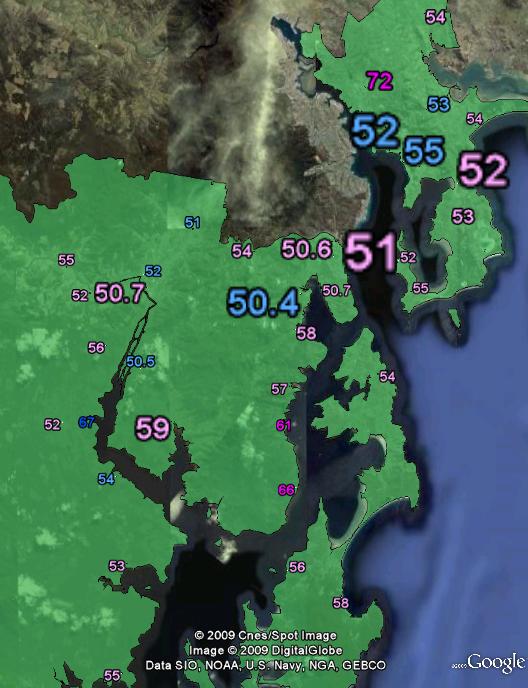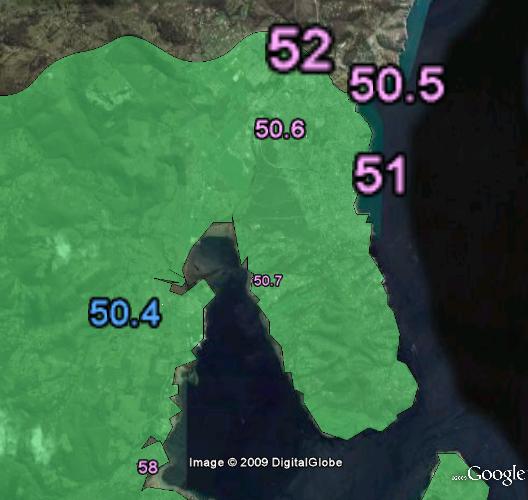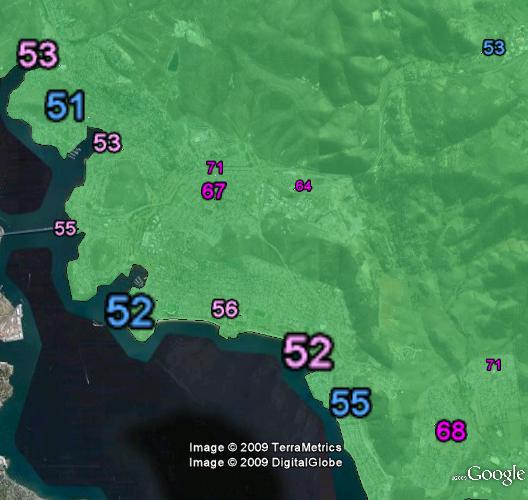ALP 4.0%
Incumbent MP
Julie Collins, since 2007.
Geography
Franklin covers the southern parts of Tasmania and the eastern suburbs of Hobart. The seat is divided into two parts, with each covering half of the voters in the electorate. Half live on the eastern shore of the Derwent River in Clarence and Brighton LGAs, while the other half lives to the south and west of Hobart in Kingborough and Huon Valley LGAs.
Redistribution
Prior to the redistribution, Franklin shared three local government areas with Lyons: Derwent Valley, Brighton and Clarence. The redistribution transferred the remainder of Clarence from Lyons into Franklin and the remainder of Derwent Valley from Franklin into Lyons. In addition, Lyons gained Bridgewater and Gagebrook from Franklin in northern Hobart. Franklin also lost a small part of Kingborough LGA to the north of Kingston, with the boundary with Denison being shifted south to the Huon Highway.
History
Franklin was created for the 1903 election. The seat was first held by William McWilliams, who was a member at various times of the minor Revenue Tariff party, the Free Traders, the Commonwealth Liberal Party and the Nationalists, before becoming the first leader of the Country Party in 1920. He lost his seat in 1922 to the Nationalist candidate. He won the seat back as an independent in 1928 and retained it at the 1929 election but died shortly after the declaration of the poll.
The by-election was won by Charles Frost of the ALP, who lost his seat in 1931 to the United Australia Party before winning it back in 1934. He went on to serve as Minister for Repatriation under John Curtin before he lost the seat to Charles Falkinder of the Liberal Party in 1946. Falkinder held the seat until his retirement in 1966, and Ray Sherry of the ALP won the seat in 1969. Sherry lost the seat to Bruce Goodluck in 1975. Goodluck held the seat for the Liberal Party until he was defeated by Harry Quick in 1993.
Quick held the seat until the 2007 election, and he announced his impending retirement in 2005. He caused controversy in 2006 by endorsing a Greens candidate, sitting MP Nick McKim, for the state seat of Franklin in the state election. The ALP originally preselected Electrical Trades Union official Kevin Harkins, Quick openly criticised Harkins and was seen to be supporting Liberal candidate Vanessa Goodwin. Harkins was eventually replaced as the ALP candidate by ALP state secretary Julie Collins, and Quick was expelled from the ALP, supposedly for not paying his membership fees.
At the election, despite the general swing to the ALP nationally, there was a strong swing against the ALP in Franklin, with Collins suffering a 5% swing on primary votes and 3% on two-party-preferred votes.
Candidates
- Wendy Heatley (Greens)
- John Forster (Independent)
- Jane Howlett (Liberal)
- Julie Collins (Labor) – Member for Franklin since 2007.
Political situation
Franklin is now considered to be a marginal seat, and the ALP suffered in 2007 through the absence of Harry Quick and controversy over the party’s choice of candidate. Despite the slim margin, the lack of controversy in 2010 should allow the ALP to maintain their hold on the seat. The Liberal candidate in 2007, Vanessa Goodwin, will also not be contesting. Goodwin performed strongly in Franklin in both the 2006 state election (where she came close to winning) and the 2007 federal election, and was recently elected to the Legislative Council for the overlapping seat of Pembroke.
2007 result
| Candidate | Party | Votes | % | Swing |
| Julie Collins | ALP | 27,990 | 41.39 | -5.03 |
| Vanessa Goodwin | LIB | 27,742 | 41.02 | +2.35 |
| Gerard Velnaar | GRN | 9,769 | 14.44 | +3.26 |
| Gino Papiccio | FF | 1,504 | 2.22 | -0.98 |
| Matt Holloway | SA | 365 | 0.54 | +0.01 |
| Roger Honey | CEC | 262 | 0.39 | +0.39 |
2007 two-candidate-preferred result
| Candidate | Party | Votes | % | Swing |
| Julie Collins | ALP | 36,845 | 54.48 | -3.11 |
| Vanessa Goodwin | LIB | 30,787 | 45.52 | +3.11 |
These results do not take into consideration the effects of the redistribution.
Booth breakdown
I have broken down Franklin into the three local government areas that cover the vast majority of the electorate. A small part of Brighton LGA is also included in Franklin, but the only two polling places in Brighton were transferred to Lyons, so I have ignored that area. There isn’t a great deal of variation between the three local government areas. Clarence LGA (covering a majority of the electorate) registered a 55% two-party-preferred vote for the ALP, while a vote of just over 52% was registered in both Kingborough and Huon Valley LGAs. The Greens poll substantially higher in the western part of the electorate, polling about 18% to the southwest of Hobart, while polling less than 12% in Clarence LGA.
| Voter group | GRN % | ALP 2CP % | Total votes | % of ordinary votes |
| Clarence | 11.92 | 55.03 | 27,866 | 53.20 |
| Kingborough | 18.14 | 52.17 | 16,641 | 31.77 |
| Huon Valley | 17.48 | 52.47 | 7,870 | 15.03 |
| Other votes | 15.86 | 54.04 | 12,518 |





Quick also invited expulsion from the ALP in 2005 when he broke the caucus pledge twice in voting against anti-terrorism legislation.
Although I don’t think they can win this seat, after scoring 27% in the state elections, the Greens have an outside chance to jump into 2nd place in Franklin.
Except that both major parties’ primary votes are so high, which one would they get ahead of?
As I said, an outside chance.
If the Greens can repeat their 27% from the state election, it would leave 73% to be split between the two parties, 36.5% if split evenly.
Unsuccessful state election candidate Jane Howlett has nominated for the Liberal preselection.
It actually seems quite bizarre to have an electorate divided into two completely disjointed halves. Why couldn’t they put the north-eastern part of Franklin together with the northern half of Denison, and put the southern half of Denison with the southern half of Franklin? The southern seat would then be a very strong one for the Greens.
Apparently that is confirmed that Howlett is the Liberal candidate:
http://www.abc.net.au/news/stories/2010/05/17/2901183.htm
“It actually seems quite bizarre to have an electorate divided into two completely disjointed halves. Why couldn’t they put the north-eastern part of Franklin together with the northern half of Denison, and put the southern half of Denison with the southern half of Franklin?”
You would be putting a lot less than the northern half of Denison in with the Eastern Shore if you did that, because the Eastern Shore part of the electorate has far more voters than the Huon Valley.
Some kind of community of interest could be argued between the far northern suburbs and the eastern shore but you’d still end up putting an arbitrary line through Denison to decide which bit to combine with over the river, and the rest of Denison would become a largely capital city electorate with a big rural component, but most likely with some of the Glenorchy LGA in and some out.
Franklin is a very oddly cut-in-two electorate (beyond being “satellite” to the capital city the two halves have almost nothing in common) but I think the approach that has been taken is that one extremely cohesive electorate plus one complete dog’s breakfast is better than two semi-mishmashes. Anyone who can come up with a perfect solution to this should apply for a medal or something.
I don’t know that Howlett is that strong a candidate for the Libs. She might do well in the south of the electorate because of her rural links but I don’t know what appeal she will have in the urban sections. She has a hard act to follow both in terms of the Libs having a good candidate (now state MLC) last time and the Labor preselection disaster with Harkins in 2007.
The Green vote in Franklin at the state election was boosted by a huge personal vote for extremely popular Greens leader Nick McKim. At least four points of the 27 was 1 McKim 2 somebody non-Green. (Possibly more as there were apparently a lot of 1 McKim 2 Hodgman votes, but I don’t think many of those would have returned to the Greens for #3). They absolutely won’t get near 27 in Franklin at the federal poll. Anything over 19 would be a very good result.
Although the ERMS poll always puts a * against the numbers for each state electorate, it is still worth noting the recent poll gave the Greens 36%.
http://www.emrs.com.au/pdfs/State%20Voting%20Intentions%20May%202010%20Poll.pdf
* It is important to note that the numbers in each electoral division are too small from which to draw definitive conclusions.
The sample size for Franklin was 201 which gives a margin of error for a reading of 36 of 6.6%. It seems well up on the state election result of 27.4% but given EMRS’s flawed practice of redistributing their undecided vote proportionally, the 36 should really be 34. While there is a whiff of a suggestion there that Green support in Franklin has significantly increased since the state election, EMRS also had the Greens at 36 in Denison before both the last two state elections and in both cases overshot by nearly twice the margin of error. So I would not read anything into that 36 in Franklin federally, except that the Greens are not exactly on the nose in that electorate at the moment.
This will probably be a low enthusiasm election which is good for sitting MPs.
Wendy Heatley is the Greens candidate.
They could have done a lot worse, though I think they should have announced their candidate earlier. Heatley polled reasonably in the Pembroke by-election last year (though her unexpected second place on primaries was more an indictment on most of the rest of the field than a case of the Green vote being all that high) and did extremely well in the 2010 state election, almost finishing ahead of the endorsed Green #2 (who was a poor choice himself but that’s another story.)
So, female candidates for all of Labor, Liberal and Green – I wonder how many other Australian seats that is the case for.
Macquarie is another.
My prediction: Labor retain, 3% swing to them.